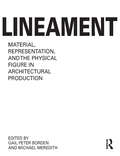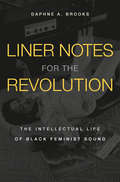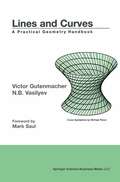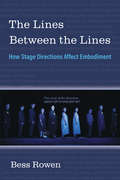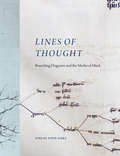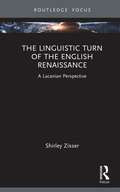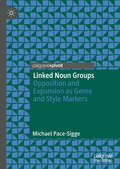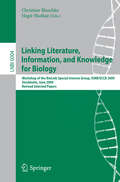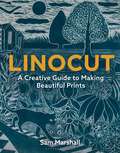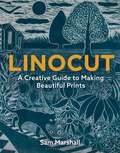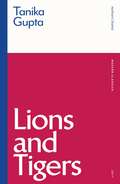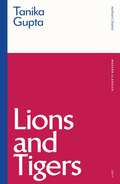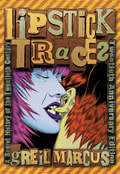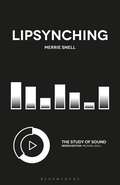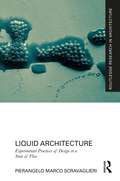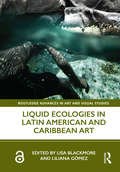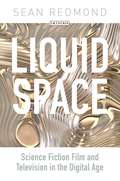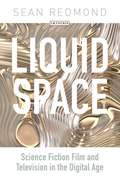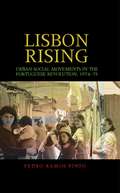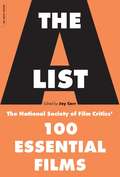- Table View
- List View
Lineament: Material, Representation and the Physical Figure in Architectural Production
by Gail Peter Borden and Michael MeredithThis comprehensive catalogue of contemporary work examines the renewed investment in the relationship between representation, materiality, and architecture. It assembles a range of diverse voices across various institutions, practices, generations, and geographies, through specific case studies that collectively present a broader theoretical intention.
Liner Notes for the Revolution: The Intellectual Life of Black Feminist Sound
by Daphne A. BrooksAn award-winning Black feminist music critic takes us on an epic journey through radical sound from Bessie Smith to Beyoncé. Daphne A. Brooks explores more than a century of music archives to examine the critics, collectors, and listeners who have determined perceptions of Black women on stage and in the recording studio. How is it possible, she asks, that iconic artists such as Aretha Franklin and Beyoncé exist simultaneously at the center and on the fringe of the culture industry? Liner Notes for the Revolution offers a startling new perspective on these acclaimed figures—a perspective informed by the overlooked contributions of other Black women concerned with the work of their musical peers. Zora Neale Hurston appears as a sound archivist and a performer, Lorraine Hansberry as a queer Black feminist critic of modern culture, and Pauline Hopkins as America’s first Black female cultural commentator. Brooks tackles the complicated racial politics of blues music recording, song collecting, and rock and roll criticism. She makes lyrical forays into the blues pioneers Bessie Smith and Mamie Smith, as well as fans who became critics, like the record-label entrepreneur and writer Rosetta Reitz. In the twenty-first century, pop superstar Janelle Monae’s liner notes are recognized for their innovations, while celebrated singers Cécile McLorin Salvant, Rhiannon Giddens, and Valerie June take their place as cultural historians. With an innovative perspective on the story of Black women in popular music—and who should rightly tell it—Liner Notes for the Revolution pioneers a long overdue recognition and celebration of Black women musicians as radical intellectuals.
Lines and Curves: A Practical Geometry Handbook
by Victor Gutenmacher N.B. VasilyevBroad appeal to undergraduate teachers, students, and engineers; Concise descriptions of properties of basic planar curves from different perspectives; useful handbook for software engineers; A special chapter---"Geometry on the Web"---will further enhance the usefulness of this book as an informal tutorial resource.; Good mathematical notation, descriptions of properties of lines and curves, and the illustration of geometric concepts facilitate the design of computer graphics tools and computer animation.; Video game designers, for example, will find a clear discussion and illustration of hard-to-understand trajectory design concepts.; Good supplementary text for geometry courses at the undergraduate and advanced high school levels
The Lines Between the Lines: How Stage Directions Affect Embodiment
by Bess RowenWhat is the purpose of a stage direction? These italicized lines written in between the lines of spoken dialogue tell us a great deal of information about a play's genre, mood, tone, visual setting, cast of characters, and more. Yet generations of actors have been taught to cross these words out as records of previous performances or signs of overly controlling playwrights, while scholars have either treated them as problems to be solved or as silent lines of dialogue. Stage directions can be all of these things, and yet there are examples from over one-hundred years of American playwriting that show that stage directions can also be so much more. The Lines Between the Lines focuses on how playwrights have written stage directions that engage readers, production team members, and scholars in a process of embodied creation in order to determine meaning. Author Bess Rowen calls the products of this method “affective stage directions” because they reach out from the page and affect the bodies of those who encounter them. Affective stage directions do not tell a reader or production team what a given moment looks like, but rather how a moment feels. In this way, these stage directions provide playgrounds for individual readers or production teams to make sense of a given moment in a play based on their own individual cultural experience, geographic location, and identity-markers. Affective stage directions enable us to check our assumptions about what kinds of bodies are represented on stage, allowing for a greater multitude of voices and kinds of embodied identity to make their own interpretations of a play while still following the text exactly. The tools provided in this book are as useful for the theater scholar as they are for the theater audience member, casting director, and actor. Each chapter covers a different function of stage directions (spoken, affective, choreographic, multivalent, impossible) and looks at it through a different practical lens (focusing on actors, directors, designers, dramaturgs, and readers). Every embodied person will have a slightly different understanding of affective stage directions, and it is precisely this diversity that makes these stage directions crucial to understanding theater in our time.
Lines of Thought: Branching Diagrams and the Medieval Mind
by Ayelet Even-EzraWe think with objects—we conduct our lives surrounded by external devices that help us recall information, calculate, plan, design, make decisions, articulate ideas, and organize the chaos that fills our heads. Medieval scholars learned to think with their pages in a peculiar way: drawing hundreds of tree diagrams. Lines of Thought is the first book to investigate this prevalent but poorly studied notational habit, analyzing the practice from linguistic and cognitive perspectives and studying its application across theology, philosophy, law, and medicine. These diagrams not only allow a glimpse into the thinking practices of the past but also constitute a chapter in the history of how people learned to rely on external devices—from stone to parchment to slide rules to smartphones—for recording, storing, and processing information. Beautifully illustrated throughout with previously unstudied and unedited diagrams, Lines of Thought is a historical overview of an important cognitive habit, providing a new window into the world of medieval scholars and their patterns of thinking.
The Linguistic Turn of the English Renaissance: A Lacanian Perspective (Routledge Focus on Mental Health)
by Shirley ZisserThe Linguistic Turn of the English Renaissance: A Lacanian Perspective examines a selection of cultural phenomena of the English Renaissance, all of which include a focus on language, from a Lacanian perspective. The book examines four inter-related cultural symptoms of the English Renaissance: the paucity of painting, the interest in rhetoric, the emergence of a literary style focusing on form and a fascination with the myth of Orpheus. The book argues that the English Renaissance, an apex of rhetorical theory, can offer psychoanalysis further knowledge concerning the intrication of language and flesh, especially where feminine jouissance is at stake. These language-centred phenomena emerge against the backdrop of a peculiar configuration of the visual field, which in contrast to other cultures of the European Renaissance is largely barren of painting other than portraiture. The book will be of interest to psychoanalysts, scholars of Renaissance culture and those interested in the psychoanalytic study of culture.
The Linguistic Turn of the English Renaissance: A Lacanian Perspective (Routledge Focus on Mental Health)
by Shirley ZisserThe Linguistic Turn of the English Renaissance: A Lacanian Perspective examines a selection of cultural phenomena of the English Renaissance, all of which include a focus on language, from a Lacanian perspective. The book examines four inter-related cultural symptoms of the English Renaissance: the paucity of painting, the interest in rhetoric, the emergence of a literary style focusing on form and a fascination with the myth of Orpheus. The book argues that the English Renaissance, an apex of rhetorical theory, can offer psychoanalysis further knowledge concerning the intrication of language and flesh, especially where feminine jouissance is at stake. These language-centred phenomena emerge against the backdrop of a peculiar configuration of the visual field, which in contrast to other cultures of the European Renaissance is largely barren of painting other than portraiture. The book will be of interest to psychoanalysts, scholars of Renaissance culture and those interested in the psychoanalytic study of culture.
Linked Noun Groups: Opposition and Expansion as Genre and Style Markers
by Michael Pace-SiggeThis book provides a corpus-led analysis of multi-word units (MWUs) in English, specifically fixed pairs of nouns which are linked by a conjunction, such as 'mum and dad', 'bride and groom' and 'law and order'. Crucially, the occurrence pattern of such pairs is dependent on genre, and this book aims to document the structural distribution of some key Linked Noun Groups (LNGs). The author looks at the usage patterns found in a range of poetry and fiction dating from the 17th to 20th century, and also highlights the important role such binomials play in academic English, while acknowledging that they are far less common in casual spoken English. His findings will be highly relevant to students and scholars working in language teaching, stylistics, and language technology (including AI).
Linking, Literature, Information, and Knowledge for Biologie: Workshop of the BioLINK Special Interest Group, ISBM/ECCB 2009, Stockholm, June 28-29, 2009, Revised Selected Papers (Lecture Notes in Computer Science #6004)
by Hagit Shatkay Christian BlaschkeLinocut: A Creative Guide to Making Beautiful Prints
by Sam MarshallA step-by-step guide on how to create personal and contemporary linocut prints.A linocut is a relief print created by carving a design into a printing block. It is the uncut surface, not the carved away areas, that gives you your image when you roll it with ink, lay paper on top then apply pressure to produce a print. With 18 easy-to-follow projects that can be adapted to suit your own ideas, experienced printmaker Sam Marshall guides you through the whole process – from the drawing to the carving to the inking to the printing – of creating your own beautiful prints and handmade cards whether you are working from your kitchen table or a more advanced studio set-up. By taking inspiration from everyday life, Sam helps you to build your confidence with observational drawing. Featuring step-by-step projects, the book demonstrates a range of skills with low-cost materials to produce simple linocuts, reduction linocuts and colourful multi-block prints. You will also learn more experimental techniques such as combining monoprint, chine collé, jigsaw linocuts and rainbow rolls and pick up handy tips on subjects such as 'noise' and editioning your prints. Beautifully illustrated with photographs of Sam's own drawings and linocuts, and featuring the work of 5 talented printmakers, Linocut is an essential guide to linocut printmaking. Packed with creative and practical advice to guide and encourage you, whether you're just starting out, returning to the craft or looking to expand your printmaking skills.
Linocut: A Creative Guide to Making Beautiful Prints
by Sam MarshallA step-by-step guide on how to create personal and contemporary linocut prints.A linocut is a relief print created by carving a design into a printing block. It is the uncut surface, not the carved away areas, that gives you your image when you roll it with ink, lay paper on top then apply pressure to produce a print. With 18 easy-to-follow projects that can be adapted to suit your own ideas, experienced printmaker Sam Marshall guides you through the whole process – from the drawing to the carving to the inking to the printing – of creating your own beautiful prints and handmade cards whether you are working from your kitchen table or a more advanced studio set-up. By taking inspiration from everyday life, Sam helps you to build your confidence with observational drawing. Featuring step-by-step projects, the book demonstrates a range of skills with low-cost materials to produce simple linocuts, reduction linocuts and colourful multi-block prints. You will also learn more experimental techniques such as combining monoprint, chine collé, jigsaw linocuts and rainbow rolls and pick up handy tips on subjects such as 'noise' and editioning your prints. Beautifully illustrated with photographs of Sam's own drawings and linocuts, and featuring the work of 5 talented printmakers, Linocut is an essential guide to linocut printmaking. Packed with creative and practical advice to guide and encourage you, whether you're just starting out, returning to the craft or looking to expand your printmaking skills.
Lions and Tigers (Modern Classics)
by Tanika Gupta"Tanika Gupta's epic drama pushes the boundaries of verbatim theatre, telling an important story in a fresh and authentic way never seen on stage before. A rousing piece of work." - Greg Walker, Regius Professor of Rhetoric and English Literature, University of Edinburgh, UK. Based on the true story of Tanika Gupta's great uncle, Lions and Tigers follows nineteen-year-old Dinesh Gupta's emotional and political awakening as a freedom fighter pitting himself against the British Raj.Drawn from family stories that the playwright herself heard from early childhood, the play teems with details drawn from her grandfather's 500-page handwritten journal about his younger brother, and from the 92 letters written by her great uncle from his prison cell.Set against the backdrop of negotiations between the leaders of the Indian National Congress and culminating in actions that shook the very foundations of the British Empire, Lions and Tigers challenges our assumptions about Indian independence and offers powerful new insights into the battles between the British lions and the Bengal tigers. The play was first performed at Shakespeare's Globe from the 23rd August to 16th September 2017, and was awarded the James Tait Black Prize for Drama in 2018. It is published here in Methuen Drama's Modern Classics series for the first time, with a brand new introduction.
Lions and Tigers (Modern Classics)
by Tanika Gupta"Tanika Gupta's epic drama pushes the boundaries of verbatim theatre, telling an important story in a fresh and authentic way never seen on stage before. A rousing piece of work." - Greg Walker, Regius Professor of Rhetoric and English Literature, University of Edinburgh, UK. Based on the true story of Tanika Gupta's great uncle, Lions and Tigers follows nineteen-year-old Dinesh Gupta's emotional and political awakening as a freedom fighter pitting himself against the British Raj.Drawn from family stories that the playwright herself heard from early childhood, the play teems with details drawn from her grandfather's 500-page handwritten journal about his younger brother, and from the 92 letters written by her great uncle from his prison cell.Set against the backdrop of negotiations between the leaders of the Indian National Congress and culminating in actions that shook the very foundations of the British Empire, Lions and Tigers challenges our assumptions about Indian independence and offers powerful new insights into the battles between the British lions and the Bengal tigers. The play was first performed at Shakespeare's Globe from the 23rd August to 16th September 2017, and was awarded the James Tait Black Prize for Drama in 2018. It is published here in Methuen Drama's Modern Classics series for the first time, with a brand new introduction.
Lipstick Traces: A Secret History Of The Twentieth Century
by Greil MarcusThis is a secret history of modern times, told by way of what conventional history tries to exclude. Lipstick Traces tells a story as disruptive and compelling as the century itself.
Lipsynching (The Study of Sound)
by Merrie SnellWhat does it mean when a singing voice is detached from an originating body through recording? And how does this affect consumers of recorded song? This book examines the practice of lipsynching to pre-recorded song in both professional and vernacular contexts, covering over a century of diverse artistic practices from early cinema through to the current popularity of self-produced internet lipsynching videos. It examines the ways in which we listen to, respond to, and use recorded music, not only as a commodity to be consumed but as a culturally-sophisticated and complex means of identification, a site of projection, introjection, and habitation, and, through this, a means of personal and collective creativity.
Lipsynching (The Study of Sound)
by Merrie SnellWhat does it mean when a singing voice is detached from an originating body through recording? And how does this affect consumers of recorded song? This book examines the practice of lipsynching to pre-recorded song in both professional and vernacular contexts, covering over a century of diverse artistic practices from early cinema through to the current popularity of self-produced internet lipsynching videos. It examines the ways in which we listen to, respond to, and use recorded music, not only as a commodity to be consumed but as a culturally-sophisticated and complex means of identification, a site of projection, introjection, and habitation, and, through this, a means of personal and collective creativity.
Liquid Architecture: Experimental Practices of Design in a State of Flux (Routledge Research in Architecture)
by Pierangelo Marco ScravaglieriLiquid Architecture challenges the idea of architecture as a fixed, inert container and reconceptualises it as a body whose boundaries are rather blurred and ever-changing. This book moves away from form as the primary driver of spatial protocols and explores what the built environment might look like when viewed through the lenses of a ‘wet ontology’ that is attentive to fluidity, flows and territorial dynamism. A reconfiguration of architectural materials and authorship is thus considered, leading, in turn, to an exploration of the ethical dimensions of co-designing with natural systems (of various viscosities) through liquid paradigms. The book examines a set of principles for practice-led discoveries that incorporate hybrid, mixed media with the author’s intersubjective relationship with liquid matter. Drawing from qualitative-based analytical investigation models, the text allows comprehension of the liquid phenomena via material contextualisation of an ever-becoming research setting. Through a practical and theoretical engagement with the ontology of liquids, the reader is exposed to a range of design-led experiments and creative propositions, visualisation systems, construction, and testing of physical models that collectively translate into a series of novel insights for architectural agendas. This book will be of interest to architecture and design research students and academics because it advocates the need for a more symbiotic and resilient approach to natural systems, which could benefit from the integration of regenerating material flows into our buildings and urban settlements.
Liquid Architecture: Experimental Practices of Design in a State of Flux (Routledge Research in Architecture)
by Pierangelo Marco ScravaglieriLiquid Architecture challenges the idea of architecture as a fixed, inert container and reconceptualises it as a body whose boundaries are rather blurred and ever-changing. This book moves away from form as the primary driver of spatial protocols and explores what the built environment might look like when viewed through the lenses of a ‘wet ontology’ that is attentive to fluidity, flows and territorial dynamism. A reconfiguration of architectural materials and authorship is thus considered, leading, in turn, to an exploration of the ethical dimensions of co-designing with natural systems (of various viscosities) through liquid paradigms. The book examines a set of principles for practice-led discoveries that incorporate hybrid, mixed media with the author’s intersubjective relationship with liquid matter. Drawing from qualitative-based analytical investigation models, the text allows comprehension of the liquid phenomena via material contextualisation of an ever-becoming research setting. Through a practical and theoretical engagement with the ontology of liquids, the reader is exposed to a range of design-led experiments and creative propositions, visualisation systems, construction, and testing of physical models that collectively translate into a series of novel insights for architectural agendas. This book will be of interest to architecture and design research students and academics because it advocates the need for a more symbiotic and resilient approach to natural systems, which could benefit from the integration of regenerating material flows into our buildings and urban settlements.
Liquid Ecologies in Latin American and Caribbean Art (Routledge Advances in Art and Visual Studies)
by Lisa Blackmore Liliana GómezThis interdisciplinary book brings into dialogue research on how different fluids and bodies of water are mobilised as liquid ecologies in the arts in Latin America and the Caribbean. Examining the visual arts, including multimedia installations, performance, photography and film, the chapters place diverse fluids and systems of flow in art historical, ecocritical and cultural analytical contexts. The book will be of interest to scholars of art history, cultural studies, environmental humanities, blue humanities, ecocriticism, Latin American and Caribbean studies, and island studies.
Liquid Ecologies in Latin American and Caribbean Art (Routledge Advances in Art and Visual Studies)
by Lisa Blackmore Liliana GómezThis interdisciplinary book brings into dialogue research on how different fluids and bodies of water are mobilised as liquid ecologies in the arts in Latin America and the Caribbean. Examining the visual arts, including multimedia installations, performance, photography and film, the chapters place diverse fluids and systems of flow in art historical, ecocritical and cultural analytical contexts. The book will be of interest to scholars of art history, cultural studies, environmental humanities, blue humanities, ecocriticism, Latin American and Caribbean studies, and island studies.
Liquid Space: Science Fiction Film and Television in the Digital Age
by Sean RedmondIn this remarkable and original book, Sean Redmond examines the issues and themes that are repeatedly found across a range of contemporary science fiction films and television programmes. He argues that they reveal the profound effects the digital age has had on our social lives. Through narratives that feature the 'post-human', genetic engineering and cloning, surveillance and data mining, space and time travel, artificial intelligence, online dating cultures and visions of catastrophe, they portray a world in which the material, and the stable, are being lost to the ever-more volatile and ephemeral idea of 'liquid space'. Redmond examines a wide selection of popular films and TV series such as Gravity, Under the Skin, The Lobster, Children of Men and Doctor Who, to locate how traditional values are being erased in favour of a new liquid modernity. Drawing on an eclectic range of approaches from phenomenology to critical race theory, and from close textual analysis to the revelations of eye-tracking technology, this book is an illuminating account of the digital age through the lens of science fiction.
Liquid Space: Science Fiction Film and Television in the Digital Age (International Library of the Moving Image (PDF))
by Sean RedmondScience fiction is perhaps the most effective genre to explore the concerns of the present whilst reflecting on the possibilities of the future. But what precisely can it tell us about present and future by setting these two timeframes in the same critical space?
Lisbon rising: Urban social movements in the Portuguese Revolution, 1974–75 (PDF)
by Pedro PintoLisbon rising explores the role of a widespread urban social movement in the revolutionary process that accompanied Portugal’s transition from authoritarianism to democracy. It is the first in-depth study of the widest urban movement of the European post-war period, an event that shook the balance of Cold War politics by threatening the possibility of revolution in Western Europe. Using hitherto unknown sources produced by movement organisations themselves, it challenges long-established views of civil society in Southern Europe as weak, arguing that popular movements had an important and autonomous role in the process that led to democratisation, inviting us to rethink the history and theories of transitions in the region in ways that account for popular agency. Lisbon rising will be of interest not only to students of twentieth-century European history, but across disciplines to students of democratisation, social movements and citizenship in political science and sociology.
Lisbon rising: Urban social movements in the Portuguese Revolution, 1974–75
by Pedro PintoLisbon rising explores the role of a widespread urban social movement in the revolutionary process that accompanied Portugal’s transition from authoritarianism to democracy. It is the first in-depth study of the widest urban movement of the European post-war period, an event that shook the balance of Cold War politics by threatening the possibility of revolution in Western Europe. Using hitherto unknown sources produced by movement organisations themselves, it challenges long-established views of civil society in Southern Europe as weak, arguing that popular movements had an important and autonomous role in the process that led to democratisation, inviting us to rethink the history and theories of transitions in the region in ways that account for popular agency. Lisbon rising will be of interest not only to students of twentieth-century European history, but across disciplines to students of democratisation, social movements and citizenship in political science and sociology.
A List: The National Society Of Film Critics' 100 Essential Films
by Jay CarrPeople love movies. People love lists. So The A-List is a natural. While there are plenty of encyclopedic lists of films, this compulsively readable book of 100 essays -- most written expressly for this volume-flags the best of the best as chosen by a consensus of the National Society of Film Critics. The Society is a world-renowned, marquee -- name organization embracing some of America's most distinguished critics: more than forty writers who have national followings as well as devoted local constituencies in such major cities as New York, Chicago, Los Angeles, Boston, Philadelphia, Atlanta, and Minneapolis. But make no mistake about it: This isn't a collection of esoteric "critic's choice" movies. The Society has made its selections based on a film's intrinsic merits, its role in the development of the motion-picture art, and its impact on culture and society. Some of the choices are controversial. So are some of the omissions. It will be a jumping-off point for discussions for years to come. And since the volume spans all international films from the very beginning, it will act as a balance to recent guides dominated by films of the last two decades (hardly film's golden age). Here is a book that is definitely ready for its close-up.
